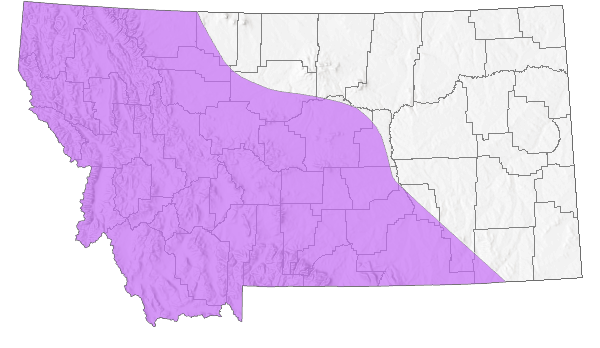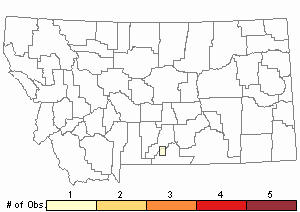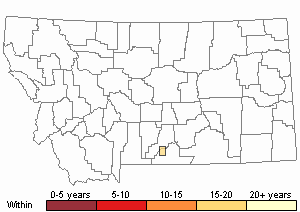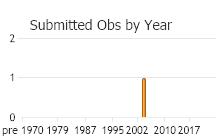View in other NatureServe Network Field Guides
NatureServe
Montana
Utah
Wyoming
Idaho
Wisconsin
British Columbia
South Carolina
Yukon
California
New York
Christina Sulphur - Colias christina
Native Species
Global Rank:
G5
State Rank:
S5
Agency Status
USFWS:
USFS:
BLM:
External Links
General Description
Variously considered a subspecies of Colias alexandra, a subspecies of C. occidentalis, and a full species (Masters 1975; Scott 1986; Ferris 1993; Pyle 2002; Hammond and McCorkle 2003, 2008; Warren 2005). Perhaps the most appropriate term applied to members of this species complex, which includes C. christina, is "stenchospecies" for taxa that "will stink up every person studying them even if he does a thorough 'ideal' study" (Scott et al 2006:1). Given the taxonomic uncertainty and instability, this account probably includes information pertaining to more than one species.
[From Ferris and Brown 1981; Scott 1986; Ferris 1993; Opler and Wright 1999; Glassberg 2001; Scott et al. 2006] Forewing 2.4-2.9 cm. Fringes pink; wing coloration variable. Uppersurface of male forewing with over 2/3 orange, wing base yellow, sometimes with abrupt transition between colors but more often diffuse, border black; female coloration similar, or pale orange to white, border black to nearly no markings. Undersurface of forewing yellow, hindwing olive-green to greenish-orange, with a single reddish-rimmed cell spot, sometimes with faint to prominent submarginal spots.
Phenology
One flight; mainly June to early August (Glassberg 2001). Late April to mid-July in Oregon (Warren 2005), June and July in British Columbia (Guppy and Shepard 2001), mid-June to late September in Montana (Scott et al. 2006).
Diagnostic Characteristics
Probably best distinguished by a combination of habitat and coloration: the uppersurface of male forewing with over 2/3 orange, wing base yellow, the transition abrupt to diffuse; females similar but paler to whitish. Undersurface of hindwing olive-green to greenish-orange, with a single reddish-rimmed cell spot, sometimes with faint to prominent submarginal spots.
Species Range
Montana Range
Range Descriptions

 Native
Native
Range Comments
Eastern Alaska and western Northwest Territories south through northeastern British Columbia, Alberta, southern Saskatchewan, southern Manitoba to northern Wyoming and the Black Hills region of western South Dakota (Opler and Wright 1999; Glassberg 2001); 1067 m to at least 1524 m elevation in Oregon (Warren 2005), to 2720 m elevation in Wyoming (Scott et al. 2006), to about 2500 m elevation in Alberta (Ezzeddine and Matter 2008). In Montana, reported under C. alexandra astraea (Kohler 1980), C. occidentalis christina and C. o. astraea (Stanford and Opler 1993), and most recently as C. christina christina and C. c. sacajawea (Guppy and Shepard 2001; Scott et al. 2006), mostly east of the continental divide in at least 19 counties in the western 1/2 of the state, to at least 2591 m elevation. Probably uncommon to common (Glassberg 2001).
Observations in Montana Natural Heritage Program Database
Number of Observations: 13
(Click on the following maps and charts to see full sized version)
Map Help and Descriptions
Relative Density

Recency



 (Observations spanning multiple months or years are excluded from time charts)
(Observations spanning multiple months or years are excluded from time charts)
Migration
Non-migratory.
Habitat
Montane forest openings, open coniferous woodland, roadsides, power line corridors (Ferris 1993; Opler and Wright 1999; Glassberg 2001; Guppy and Shepard 2001; Warren 2005). Habitat in Montana not described but probably similar; in the Greater Yellowstone Ecosystem, reported from meadows, fields, brush land, roadsides, forest clearings and edges, and sagebrush (Debinski and Pritchard 2002).
Food Habits
Larval food plants include Hedysarum (multiple species), Lathyrus (multiple species), Lupinus, Oxytropis, Thermopsis, possibly Vicea (Scott 1986; Ferris 1993; Guppy and Shepard 2001; Hammond and McCorkle 2003; Warren 2005). Adults feed on flower nectar (including Erigeron, Sedum, Solidago, Taraxacum) and mud (Ezzeddine and Matter 2008; Scott 2014).
Reproductive Characteristics
Limited information, given the taxonomic confusion of the species complex. Females lay eggs singly (perhaps as many as 600 eggs by a single female) on the upper surface of host plant leaves (Scott 1986). Eggs of C. occidentalis hatch in about 6-7 days (depending on temperature), reach L3 instar in about 17-20 days post egg-hatch then hibernate (enter diapause), develop further to L5 instar and pupate in about 20 days after exiting diapause in spring (depending on temperature); adults eclose (emerge from pupae) in about 7 weeks (James and Nunnallee 2011). Larvae of C. alexandra eat host plant leaves, build no nests, overwinter as larvae (Scott 1979; James and Nunnallee 2011). Males patrol throughout the day in open areas, valley bottoms, hillsides, in search of females (Scott 1975b, 1986).
Stewardship Responsibility
References
- Literature Cited AboveLegend:
 View Online Publication
View Online Publication Debinski, D.M. and J.A. Pritchard. 2002. A field guide to the butterflies of the Greater Yellowstone Ecosystem. Lanham, MD: Roberts Rinehart Publishers. 107 p.
Debinski, D.M. and J.A. Pritchard. 2002. A field guide to the butterflies of the Greater Yellowstone Ecosystem. Lanham, MD: Roberts Rinehart Publishers. 107 p. Ezzeddine, M. and S.F. Matter. 2008. Nectar flower use and electivity by butterflies in sub-alpine meadows. Journal of the Lepidopterists' Society 62(3): 138-142.
Ezzeddine, M. and S.F. Matter. 2008. Nectar flower use and electivity by butterflies in sub-alpine meadows. Journal of the Lepidopterists' Society 62(3): 138-142. Ferris, C.D. 1993. Reassessment of the Colias Alexandra Group, the Legume-Feeding Species, and Preliminary Cladistic Analysis of the North American Colias (Pieridae: Coliadinae). Bulletin of the Allyn Museum 138: 1-91.28.
Ferris, C.D. 1993. Reassessment of the Colias Alexandra Group, the Legume-Feeding Species, and Preliminary Cladistic Analysis of the North American Colias (Pieridae: Coliadinae). Bulletin of the Allyn Museum 138: 1-91.28. Ferris, C.D. and F.M. Brown (eds). 1981. Butterflies of the Rocky Mountains. Univ. of Oklahoma Press. Norman. 442 pp.
Ferris, C.D. and F.M. Brown (eds). 1981. Butterflies of the Rocky Mountains. Univ. of Oklahoma Press. Norman. 442 pp. Glassberg, J. 2001. Butterflies through Binoculars: A Field Guide to the Butterflies of Western North America. Oxford University Press.
Glassberg, J. 2001. Butterflies through Binoculars: A Field Guide to the Butterflies of Western North America. Oxford University Press. Guppy, C.S. and J.H. Shepard. 2001. Butterflies of British Columbia: including western Alberta, southern Yukon, the Alaska Panhandle, Washington, northern Oregon, northern Idaho, northwestern Montana. UBC Press (Vancouver, BC) and Royal British Columbia Museum (Victoria, BC). 414 pp.
Guppy, C.S. and J.H. Shepard. 2001. Butterflies of British Columbia: including western Alberta, southern Yukon, the Alaska Panhandle, Washington, northern Oregon, northern Idaho, northwestern Montana. UBC Press (Vancouver, BC) and Royal British Columbia Museum (Victoria, BC). 414 pp. Hammond, P.C. and D.V. McCorkle. 2003. A new desert subspecies of Colias occidentalis (Pieridae) from southeastern Oregon. Journal of the Lepidopterists' Society 57(4): 274-278.
Hammond, P.C. and D.V. McCorkle. 2003. A new desert subspecies of Colias occidentalis (Pieridae) from southeastern Oregon. Journal of the Lepidopterists' Society 57(4): 274-278. Hammond, P.C. and D.V. McCorkle. 2008. A review of geographic variation and possible evolutionary relationships in the Colias scudderii-gigantea complex of North America (Pieridae). Journal of the Lepidopterists' Society 62(4): 201-215.
Hammond, P.C. and D.V. McCorkle. 2008. A review of geographic variation and possible evolutionary relationships in the Colias scudderii-gigantea complex of North America (Pieridae). Journal of the Lepidopterists' Society 62(4): 201-215. James, D.G. and D. Nunnallee. 2011. Life histories of Cascadia butterflies. Corvallis, OR: Oregon State University Press. 447 p.
James, D.G. and D. Nunnallee. 2011. Life histories of Cascadia butterflies. Corvallis, OR: Oregon State University Press. 447 p. Kohler, S. 1980. Checklist of Montana Butterflies (Rhopalocera). Journal of the Lepidopterists' Society 34(1): 1-19.
Kohler, S. 1980. Checklist of Montana Butterflies (Rhopalocera). Journal of the Lepidopterists' Society 34(1): 1-19. Masters, J.H. 1975. Variation in Colias alexandra christina Edwards. Journal of Research on the Lepidoptera 14(3): 148-157.
Masters, J.H. 1975. Variation in Colias alexandra christina Edwards. Journal of Research on the Lepidoptera 14(3): 148-157. Opler, P.A. and A.B. Wright. 1999. A field guide to western butterflies. Second edition. Peterson Field Guides. Houghton Mifflin Company, Boston, Massachusetts. 540 pp.
Opler, P.A. and A.B. Wright. 1999. A field guide to western butterflies. Second edition. Peterson Field Guides. Houghton Mifflin Company, Boston, Massachusetts. 540 pp. Pyle, R.M. 2002. The butterflies of Cascadia: a field guide to all the species of Washington, Oregon, and surrounding territories. Seattle Audubon Society, Seattle, Washington. 420 pp.
Pyle, R.M. 2002. The butterflies of Cascadia: a field guide to all the species of Washington, Oregon, and surrounding territories. Seattle Audubon Society, Seattle, Washington. 420 pp. Scott, J.A. 1975b. Mate-locating behavior of western North American butterflies. Journal of Research on the Lepidoptera 14:1-40.
Scott, J.A. 1975b. Mate-locating behavior of western North American butterflies. Journal of Research on the Lepidoptera 14:1-40. Scott, J.A. 1979. Hibernal diapause of North American Papilionoidea and Hesperioidea. Journal of Research on the Lepidoptera 18(3): 171-200.
Scott, J.A. 1979. Hibernal diapause of North American Papilionoidea and Hesperioidea. Journal of Research on the Lepidoptera 18(3): 171-200. Scott, J.A. 1986. The butterflies of North America: a natural history and field guide. Stanford University Press, Stanford, California.
Scott, J.A. 1986. The butterflies of North America: a natural history and field guide. Stanford University Press, Stanford, California. Scott, J.A. 2014. Lepidoptera of North America 13. Flower visitation by Colorado butterflies (40,615 records) with a review of the literature on pollination of Colorado plants and butterfly attraction (Lepidoptera: Hersperioidea and Papilionoidea). Contributions of the C.P. Gillette Museum of Arthopod Diversity. Fort Collins, CO: Colorado State University. 190 p.
Scott, J.A. 2014. Lepidoptera of North America 13. Flower visitation by Colorado butterflies (40,615 records) with a review of the literature on pollination of Colorado plants and butterfly attraction (Lepidoptera: Hersperioidea and Papilionoidea). Contributions of the C.P. Gillette Museum of Arthopod Diversity. Fort Collins, CO: Colorado State University. 190 p. Scott, J.A., M.S. Fisher, N.G. Kondla, S. Kohler, C.S. Guppy, S.M. Spomer, and B.C. Schmidt. 2006. Taxonomic studies and new taxa of North American butterflies. Papilio new series #12. 80 p.
Scott, J.A., M.S. Fisher, N.G. Kondla, S. Kohler, C.S. Guppy, S.M. Spomer, and B.C. Schmidt. 2006. Taxonomic studies and new taxa of North American butterflies. Papilio new series #12. 80 p. Stanford, R.E. and P.A. Opler. 1993. Atlas of western USA butterflies: including adjacent parts of Canada and Mexico. Unpubl. Report. Denver and Fort Collins, Colorado 275 pp.
Stanford, R.E. and P.A. Opler. 1993. Atlas of western USA butterflies: including adjacent parts of Canada and Mexico. Unpubl. Report. Denver and Fort Collins, Colorado 275 pp. Warren, A.D. 2005. Lepidoptera of North America 6: Butterflies of Oregon, their taxonomy, distribution, and biology. Contributions of the C. P. Gillette Museum of Arthropod Diversity, Colorado State University. Fort Collins, Colorado. 406 pp.
Warren, A.D. 2005. Lepidoptera of North America 6: Butterflies of Oregon, their taxonomy, distribution, and biology. Contributions of the C. P. Gillette Museum of Arthropod Diversity, Colorado State University. Fort Collins, Colorado. 406 pp.
- Additional ReferencesLegend:
 View Online Publication
View Online Publication
Do you know of a citation we're missing? Allen, T.J., J.P. Brock, and J. Glassberg. 2005. Caterpillars in the field and garden: a field guide to the butterfly caterpillars of North America. Oxford University Press.
Allen, T.J., J.P. Brock, and J. Glassberg. 2005. Caterpillars in the field and garden: a field guide to the butterfly caterpillars of North America. Oxford University Press. Brock, J.P. and K. Kaufman. 2003. Kaufman Field Guide to Butterflies of North America. Houghton Mifflin Company, New York, NY 284 pp.
Brock, J.P. and K. Kaufman. 2003. Kaufman Field Guide to Butterflies of North America. Houghton Mifflin Company, New York, NY 284 pp. Caruthers, J.C., and D. Debinski. 2006. Montane meadow butterfly species distributions in the Greater Yellowstone Ecosystem. University of Wyoming National Park Service Research Center Annual Report, 2006. Vol. 30, Art. 14. 85-96.
Caruthers, J.C., and D. Debinski. 2006. Montane meadow butterfly species distributions in the Greater Yellowstone Ecosystem. University of Wyoming National Park Service Research Center Annual Report, 2006. Vol. 30, Art. 14. 85-96. Forister, M.L., E.M. Grames, C.A. Halsch, K.J. Burls, C.F. Carroll, K.L. Bell, J.P. Jahner, et al. 2023. Assessing risk for butterflies in the context of climate change, demographic uncertainty, and heterogeneous data sources. Ecological Monographs 93(3):e1584. https://doi.org/10.1002/ecm.1584
Forister, M.L., E.M. Grames, C.A. Halsch, K.J. Burls, C.F. Carroll, K.L. Bell, J.P. Jahner, et al. 2023. Assessing risk for butterflies in the context of climate change, demographic uncertainty, and heterogeneous data sources. Ecological Monographs 93(3):e1584. https://doi.org/10.1002/ecm.1584 Layberry, R.A., P.W. Hall, and J.D. LaFontaine. 1998. The Butterflies of Canada. University of Toronto Press. 280 pp. + color plates.
Layberry, R.A., P.W. Hall, and J.D. LaFontaine. 1998. The Butterflies of Canada. University of Toronto Press. 280 pp. + color plates.
- Web Search Engines for Articles on "Christina Sulphur"
- Additional Sources of Information Related to "Insects"





